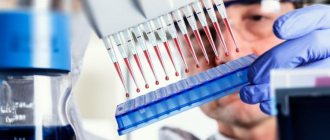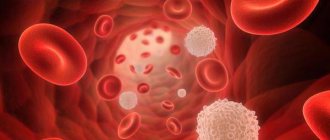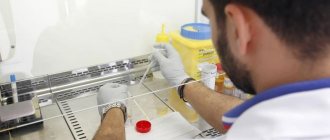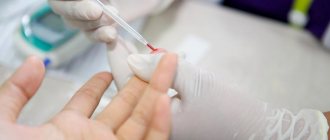What are platelets
Platelets are called nuclear-free blood cells that are synthesized by red bone marrow tissue. Their life cycle is about 7 days, after which they are utilized in the liver and spleen. In platelets, the aging process is more pronounced than in other blood cells.
Like other components of blood, platelets are divided into young, mature and old. In a healthy person, the number of mature cells should not exceed 95%. If the analysis reveals a large concentration of young cells, this indicates the development of certain diseases, including numerous damage to blood vessels and so on. In addition to young platelets, old platelets are often found in the blood plasma. This phenomenon indicates a disruption in the process of cell production and disposal.
Prices
| Platelet count according to Fonio (prescribed only together with OAC) | 750₽ |
All prices
Platelets, microscopy (counting in a stained smear using the Fonio method)
Platelets are involved in the entire process of blood coagulation, starting from the formation of a primary thrombus in the area of damage to blood vessels and ending with participation in the processes of regulating vascular permeability and tone.
The calculation of the most accurate number of platelets is carried out using the Goryaev camera and the Fonio method. The Fonio platelet count is quite accurate. The Fonio method is most convenient for automatic counting.
An important condition for the correct functioning of the coagulation system is the presence of a certain number of mature platelets in the bloodstream. Deviations in any direction can have adverse consequences. The normal platelet count in the blood differs depending on age and gender. If their level is reduced, there is a tendency to bleeding, blood clotting worsens, and is difficult to stop. If the platelet count exceeds the norm, the blood becomes thick, and there is a risk of blood clots and blockage of blood vessels.
Platelets are formed in the bone marrow from giant cells called megakaryocytes. In fact, they are fragments of these cells and are small, nuclear-free, colorless oval or round shaped plates surrounded by a membrane, including granules. The diameter of platelets ranges from 2 to 4 microns. They are usually called blood cells, like leukocytes and red blood cells, although they are not. These are postcellular structures, or Bizzazero plaques (named after the Italian scientist who made a great contribution to their study). About 2/3 of all platelets are found in the blood, the rest are found in the spleen. Functions of blood platelets
When the vascular wall is damaged, blood platelets are immediately activated. They take on a spherical shape and outgrowths appear on them, making them look like a star. Platelets in their active form are capable of sticking to each other (aggregation) and sticking to the vessel wall (adhesion). They secrete an enzyme into the blood plasma, under the influence of which soluble fibrinogen is converted into insoluble fibrin, which entangles the formed elements of the blood with its threads, like nets. The resulting thrombus closes the defect in the damaged vessel. Platelets take part in the dissolution of the fibrin clot and maintain spasm of damaged vessels. Another important function is to provide nutrients to the cells that line the inner surface of blood vessels.
Role in the body
Platelets take an active part in processes associated with the formation of blood clots. They also produce a special substance necessary for tissue regeneration, stimulation of cell division, regulation of the level of permeability of cell membranes and maintaining the elasticity of blood vessels.
The quantitative and qualitative composition of platelets is of valuable importance in the diagnosis of heart and vascular diseases. A high number of these bodies is called thrombocytosis, a low number is called thrombocytopenia.
Important! Depending on the age, the cells have different degrees of staining, which makes it possible to use this morphological feature for differential diagnosis.
What is the Fonio method?
Platelet count according to Fonio is an analysis that helps to identify the exact number of these cells in the blood and diagnose many diseases in a person. In this case, platelets are counted in a blood smear per thousand red blood cells, after which this number is recalculated in the ratio of 1 microliter or liter. The technique is considered very accurate and is used to diagnose many pathologies.
During the analysis, the blood is stained using the Romanovsky-Giemsa method
To carry out the analysis, blood is taken from a finger. The total number of platelets in a unit of blood is called a coagulogram. This type of study is prescribed to every patient, because the analysis helps to suspect and identify many diseases.
Advantages of the method
Currently, there are several methods for counting platelet levels: fluorescent microscopy, the use of electronic automatic counters, and the use of a Gryazev camera. However, in the vast majority of cases, it is the Fonio method that is used.
Positive aspects of such a study:
- high accuracy - achieved through the use of a special form of calculation, the components of which are easily detected in a drop of blood;
- speed of implementation - the period of time from the moment of collection of biological material until the results are obtained is no more than 2 hours, and with the use of the latest high-precision equipment, the entire procedure takes no more than half an hour;
- there is no need for expensive reagents - to activate platelets, it is enough to introduce coagulants, and also tint the smear with a special solution.
It is these factors that make it possible to obtain more accurate information than with a general clinical blood test or coagulogram.
In addition, platelet counting according to Fonio has the following features:
- good visualization of cellular elements;
- the study of biological material can be carried out at any time, and not immediately after receiving blood;
- calculating the level of small blood platelets is facilitated by their “reference” to 1000 red blood cells per 1 milliliter of blood.
However, such a technique may have errors that are associated with poor quality of the smear or uneven distribution of platelets on a special glass.
Preparing for analysis
Several factors can affect the result of the Fonio platelet test. In this regard, it is necessary to properly prepare for donating blood. The patient should consider the following recommendations the day before collecting biological material:
We advise you to read:Normal platelets in pregnant women
- blood donation should be carried out 8 hours after the last meal, since many foods can affect the color index of blood cells;
- The day before the test you should not play sports. If a person has performed any physical activity, the test result may be inaccurate;
- material is collected in the morning;
- The most accurate information can be obtained by donating blood again. This helps to monitor platelet concentration over time.
In addition, the doctor should be sure to tell you whether you have taken any medications before. Many medications can also distort the results.
What kind of analysis
The analysis makes it possible to obtain information about the number of particles. They participate in the process of blood clotting, create blood clots, form a substance necessary for tissue repair, promote cell division, normalize the permeability of cell walls and restore the elasticity of blood vessels.
The analysis is used in the diagnosis of cardiovascular diseases. An elevated platelet count is called thrombocytosis, and a low platelet count is called thrombocytopenia. The color of the particles changes according to age.
The study of platelets using the Fonio method allows you to calculate the exact number of cells and identify many pathologies. During the study, the proportion of microparticles in a blood smear per 1000 red blood cells is calculated. This indicator is converted to 1 ml or l. This method is effective for diagnosing diseases.
During the analysis, the blood is colored. For testing, blood is taken from a finger. The number of cells in the blood is a coagulogram. This test is performed on many people. It makes it possible to diagnose various pathologies.
Advantages and disadvantages
The Fonio method has many advantages and has been used for many years.
Advantages:
- Under a microscope, the studied material, size, color and number of particles are clearly visible.
- The study is carried out at any time of the day.
- The technique is easy to use, has a simple formula, and the analysis is highly informative.
- Now other research methods have appeared, but the Folio method is more informative.
Important information: How are platelets indicated in a general blood test?
Flaws:
- While other methods allow you to immediately obtain a ready result using instruments, the laboratory assistant must visually calculate the indicators under a microscope, which takes time and requires special qualifications.
- The collection of material - red blood cells - is carried out manually.
Preparation for the procedure
The last meal should be 8 hours before the test, since some foods affect the color of the particles being tested.
The day before the test, you should not play sports and avoid physical activity. You need to come to the laboratory in the morning. Taking a repeat test makes it possible to monitor the number of cells over time. The patient must inform the doctor in advance about the medications he is taking.
Platelet count according to Fonio
When counting platelets, the laboratory technician uses several types of reagents. This is sodium ethylenediaminetetraacetate or magnesium sulfate. Reagents are taken using the SEE meter pipette.
The analysis is carried out in several stages:
- One of the reagents and blood are added to the test tube using a pipette. The amount of reagent is taken to the 75 mark, the blood volume to the K mark.
- The resulting mass is mixed well and used to make smears.
- If magnesium sulfate is used, the smear is stained using the Romanovsky-Giemsa method for 120 minutes and 45 minutes if the laboratory technician takes sodium ethylenediaminetetraacetate. In this case, the platelets turn purple-pink.
Platelet counts are performed through a microscope
Using a microscope, platelets and red blood cells are counted up to a thousand red blood cells. To find out the number of platelets, they are multiplied by the number of red blood cells in 1 microliter, and then the resulting figure is divided by a thousand. The specific color of the cells being studied helps to obtain the most reliable results. That is why many specialists use the Fonio platelet count method when making a diagnosis.
The essence of this analysis
Not every patient knows what a platelet count according to Fonio is. It is carried out on 1000 red blood cells in a material mixed with a special dye reagent. After this, the resulting number is recalculated in relation to 1 μl or 1 liter of blood.
The advantage of this method is a fairly accurate determination of the number of these blood cells, which naturally leads to a more accurate diagnosis.
Let's figure out exactly how platelets are counted according to Fonio.
Advantages of the technique
The Fonio method of counting red blood cells has been successfully used by many doctors for many years. The technique has a number of advantages, including:
- when examining blood under a microscope, the laboratory technician clearly sees the material being examined, color, shape, number of cells;
- if necessary, analysis can be carried out at any time of the day;
- the method is easy to use, which is associated with a simple formula, but at the same time very informative.
Important! Despite the fact that medicine does not stand still and today there are new methods for counting blood particles, Fonio’s method is not inferior to them in its accuracy and information content.
What low scores may indicate
Thrombocytopenia or a reduced concentration of red blood cells in a person’s blood indicates the development of various undesirable conditions. The most common reasons for low performance include:
- radiation exposure of the patient;
- exposure to lead and other harmful substances on the body;
- pathologies of the hematopoietic system;
- collagenosis in a patient (a set of diseases affecting connective tissue);
- hereditary predisposition;
- chronic nephritis.
Patients with thrombocytopenia experience clinical manifestations such as frequent nosebleeds, bleeding gums, and subcutaneous hemorrhages. In women, the disease manifests itself in the form of heavy and prolonged periods.
Thrombocytopenia causes bleeding tendency
Treatment of this condition involves eliminating the underlying cause that led to the disorder. In this case, therapy with medication is used. In particularly severe cases, removal of the spleen or bone marrow transplantation is performed.
How are platelets indicated in a blood test?
Typically, a platelet test is performed as part of a clinical blood test. Donating blood for platelets without data on the number of other blood elements is of no diagnostic value.
According to indications, additional studies of the hemostasis system are carried out (active blood coagulation time, assessment of the level of fibrinogen activity, activated partial thromboplastin time, platelet aggregation, thrombodynamic potential index, etc.).
Let's look at the abbreviations that appear in the analysis results form:
- PLT from English. Platelets – platelets;
- PDW – platelet distribution over the volume of the studied biomaterial;
- MPV – average volume of studied cells in the human body;
- P-LCR is a coefficient reflecting the number of large platelets.
Donating platelets is relevant if it is necessary to diagnose the patient’s blood coagulation system and if bone marrow pathology is suspected.
A blood test for platelets is important for people who have hematomas of unknown etiology, severe bleeding gums, nosebleeds, as well as for women with heavy menstrual bleeding. Also, a blood test for platelets is indicated for patients with thrombophlebitis, cardiovascular pathologies, atherosclerosis, and a tendency to increased thrombosis.
Reasons for increased indicators
When the number of cells in question per unit of blood increases, we are talking about thrombocytosis. As a rule, this is a secondary pathology that occurs against the background of the following conditions:
- treatment with certain medications;
- previous surgery;
- splenectomy;
- heavy blood loss;
- inflammation of the lining of the brain;
- kidney and liver pathologies;
- development of oncological formations;
- Iron-deficiency anemia.
The greatest danger of thrombocytosis is the formation of blood clots that can clog arteries. This often leads to heart attacks, strokes and other dangerous diseases.
What do elevated platelet counts indicate?
An increase in the number of platelets in the blood (thrombophilia) is observed in the following cases:
- use of certain medications;
- if the patient has undergone surgery;
- if a person has had their spleen removed;
- after injuries, if they were accompanied by large blood loss;
- when a person develops malignant neoplasms;
- with iron deficiency anemia.
If a person’s platelets are elevated, this is very dangerous for his health and life . In this case, the risk of developing thrombosis significantly increases. In this case, a blood clot forms inside the vessel, preventing normal blood flow.
An increase in the number of these cells in pregnant women is considered especially dangerous. This can have extremely unpleasant consequences:
- severe toxicosis of pregnant women;
- abortion;
- severe fetal retention;
- varicose veins during pregnancy;
- thrombosis of the legs in pregnant women;
- growth of a blood clot inside a vessel (thromboembolism);
- heart attack
In pathologies such as inflammation of the membranes of the brain, liver, lungs, and toxoplasmosis, the number of platelets also increases. This condition is accompanied by an increase in the level of leukocytes.
Cell norms in different population groups
When carrying out analysis using the Fonio method, a norm of 120 to 400 thousand cells per cubic millimeter of the material being studied is used. Fluctuation of boundaries depends on the patient’s age and gender. In women, men and children, deviations within these limits are considered normal.
Normal indicators:
- children under one year old - from 100 to 420 thousand per mm3;
- children from one year old - from 180 to 320 thousand per mm3;
- men - from 180 to 400 thousand per mm3;
- women from 180 to 340 thousand per mm3.
In adolescents, platelet levels can drop to 70 thousand per mm3. In men, the maximum number of these cells is observed at the age of 40 years. Such deviations must be taken into account when making a diagnosis and are explained by the physiological and age-related characteristics of the body.
Interpretation of results, reasons for deviations
On standard laboratory forms, platelets are designated PLT. The unit in which results are presented is thousands units per microliter. Usually, laboratory forms also indicate the norm for comparison.
The normal platelet count in the blood for men is different from the normal for women. It also depends on the age of the person.
- The norm for men is 200–400 thousand/microliter,
- For women – from 180 to 320 thousand/microliter.
Norm for children:
- In newborns up to 2 weeks - from 100 to 420 thousand / microliter,
- In babies under one year old - from 150 to 350 thousand / microliter,
- In children under 5 years old – 180-380 thousand/microliter,
- In children under 7 years old – from 180 to 150 thousand/microliter.
During menstruation, there is a normal (physiological) decrease in cells (75-200 thousand/μl). A twofold reduction in the number of platelets is associated with the need for rejection of the uterine epithelium. A decrease in platelets in pregnant women (100-300 thousand/µl) is also considered normal.
It is not recommended to take a platelet test during menstruation.
High platelets
Thrombocytosis caused by pathology of stem cells in the bone marrow is called primary.
The physiological increase in platelets as a reaction of the body to injury, alcohol consumption, infection or poisoning is called secondary. The mechanism of this reaction is associated with increased release of thrombopoietin, which stimulates the division and growth of platelets in the bone marrow.
Thrombocytosis can occur as a result of the following diseases:
- Tuberculosis,
- Myeloid leukemia,
- Anemia,
- Arthritis,
- Erythrocytosis,
- Lymphogranulomatosis,
- Acute infections
- Liver and kidney cancer.
Poisoning, stress and intense physical activity can cause an increase in platelet counts.
Important! With heavy blood loss against the background of a decrease in blood volume, the level of platelets decreases only in the first hours, and after a few hours the level can increase several times.
Low platelets
Thrombocytopenia is often caused by uncontrolled self-medication with drugs, the side effect of which is the development of thrombocytopenia.
Thrombocytopenia can be caused by the following diseases:
- Liver diseases (hepatitis, cirrhosis),
- Thyroid dysfunction (hyperthyroidism, hypothyroidism),
- Certain types of leukemia,
- Megaloblastic anemia,
- Alcoholism.
With prolonged thrombocytopenia, the walls of blood vessels become fragile, minor cuts and damage to blood vessels lead to prolonged bleeding.
To clarify the cause of low platelets and prescribe therapy, the patient will have to undergo many additional examinations (ultrasound of the liver, spleen, antibody test, MRI). A blood test for platelet count according to Fonio will need to be taken regularly.
What affects the level of platelets in the blood
The decrease or growth of the cells in question does not always indicate the development of any pathology. Sometimes the level of these cells fluctuates due to intense and regular physical activity and poor nutrition. Many people may find it strange that platelet levels increase when you lose blood. This is explained by the body’s attempt to compensate for blood loss by increased production of its formed elements.
Stress and bad habits can affect platelet levels in the blood
Rates are often elevated in people who drink alcohol for a long time. The normal platelet count is disrupted when taking medications with thrombocytopenic effects. Even a harmless nosebleed can affect the test results.
Normal values
The norm of platelets is 120-400 thousand particles per 1 mm³ smear. Microparticle levels are age appropriate.
Normal value:
- Children under 1 year - 100-420 thousand per mm³.
- Children over one year old - 180-320 thousand per mm³.
- Men - 180-400 thousand per mm³.
- The norm for women is 180-340 thousand per mm³.
- In adolescents, the number of cells can decrease to 70 thousand per mm³.
Men over 40 have the highest number of particles. The doctor takes these deviations into account when making a diagnosis.
Deviations
Deviation from the norm is not always a pathology. The number of cells can change after physical activity or with changes in diet. When bleeding occurs, the platelet count increases as the body compensates for the loss of blood by increasing the formation of cells. Particle levels are affected by stress, increased workload, and smoking.
The index increases with prolonged use of alcohol or drugs.
A decrease in the platelet rate is observed when:
- exposure to harmful substances;
- lead;
- radiation;
- blood diseases;
- connective tissue pathologies;
- jade.
Such patients often have bleeding from the nose, gums, and subcutaneous hemorrhages.
The indicator increases when treated with certain drugs, after operations, after blood loss, with inflammation of the lining of the brain, after surgical removal of the spleen. In children, elevated values of the indicator are also considered normal. In an infant, these values are higher than in an older child.
Methods for normalizing indicators
The first thing to do when detecting increased or decreased levels of platelets in the blood is to conduct a further examination of the patient in order to identify the pathology that led to this condition. The main method of treating thrombocytopenia and thrombocytosis is to combat the root cause. If the disorder develops for harmless reasons, you can increase the platelet count using the following methods:
- give up harmful foods, exclude alcoholic beverages, red grapes, green tea, blueberries, tomatoes from the diet;
- include apples, buckwheat porridge, fish dishes, bell peppers, and liver in your daily diet;
- special medications are taken as prescribed by a specialist;
- Vitamins A, B and C will help increase the number of cells.
Refusal from extreme sports, adequate assessment of stressful situations, and avoidance of conflicts at home and at work will help reduce the concentration of these blood elements.
To reduce platelets, experts recommend following the following rules:
- take acetylsalicylic acid as prescribed by your doctor;
- exclude from the diet rose hips, pomegranate, mango and other dishes that increase platelet levels;
- take magnesium supplements in courses several times a year;
- Drink at least one and a half liters of water per day.
Platelet counting using the Fonio method is one of the most accurate methods of blood testing. With the help of such an analysis, the doctor can find out many pathologies and select the appropriate treatment for the patient. This analysis is also carried out for preventive purposes, which is necessary for early diagnosis of diseases and preventing the development of serious consequences against their background.










